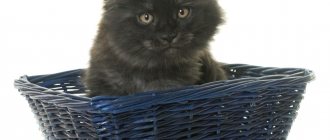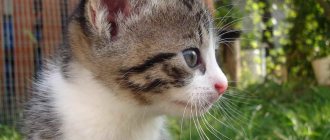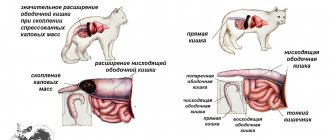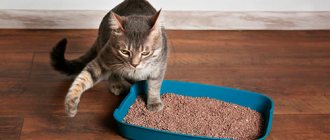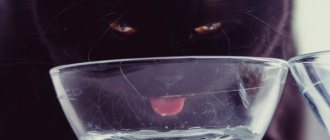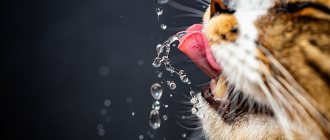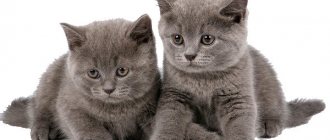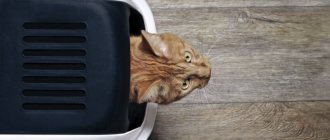Caring owners should know how often the cat goes to the toilet.
These indicators will help identify the disease at an early stage. Disturbances in defecation and urination may indicate the development of the disease. Therefore, any significant deviations from the norm are a reason to show your pet to a veterinarian.
The primary cause may be improper feeding and, as a result, disruption of the digestive system. In this case, it is enough to adjust the animal’s diet and establish the correct food intake.
Frequency of urination in cats
The daily urine volume can range from 50 to 200 ml. The frequency of urination and the amount of fluid released depends on the age, gender, and size of the animal. And also on feeding and the volume of fluid consumed.
For example, kittens can visit the litter box up to 10 times a day. This is due to the small volume of the bladder and is the norm for babies. With age, the number of visits decreases to five times a day.
Due to the physiological characteristics of the body, cats visit the litter box more often than cats. The norm for urination for an adult cat is 5–6 times. The frequency of trips to the toilet does not depend on whether the cat is neutered or not.
Adult cats go to the litter box about 3 times a day. The number of visits to the tray may increase during pregnancy and nursing. Also, the number of trips may increase when drinking large amounts of liquid, for example, in the heat or after eating dry food. If there are no natural reasons for frequent urination, then you should consult a veterinarian.
If your cat visits the litter box less than twice a day, you should immediately contact a veterinary clinic. Retention and decrease in urine volume can be symptoms of the development of pathologies in the animal’s body.
What can be done to alleviate the pet's condition?
Of course, when a cat cannot urinate, it is necessary to urgently take him to the veterinarian, but if this is not possible, then you can put a heating pad on the pet’s perineum and stomach.
Under no circumstances should you massage your cat’s tummy; these actions can only worsen your pet’s condition.
First and urgent aid is to insert a catheter to drain urine. This is a difficult and rather painful procedure and should only be carried out by a qualified specialist, and there are often cases of placing a catheter under general anesthesia. During catheterization, the bladder is washed with antiseptics. Frequent catheterization should not be performed because this procedure leads to swelling of the urinary tract, and as a result, the cat will not be able to urinate. Next, the veterinarian will determine the cause of this condition and prescribe treatment.
Diagnostics
After emergency measures are taken, the cat must undergo the necessary diagnostic procedures to identify an accurate diagnosis and prescribe the necessary treatment. Typically, a urine test is taken from the animal and an ultrasound scan of the abdominal organs, kidneys and bladder is performed.
If a cat does not walk for several days or does so rarely, then a large number of microorganisms multiply in his bladder. At first, the cat should be in a hospital so that stagnant urine can be professionally removed. Using injections, fluid is administered to the pet to eliminate dehydration. The veterinarian also prescribes antispasmodic drugs to help relieve pain and relax the urethra. Antibiotics and antibacterial agents are usually used to help relieve inflammation in the bladder. After treatment, the cat is discharged home, where all care falls on the owner.
Corrective diet
If a cat is susceptible to urolithiasis, then it needs a corrective diet. It is necessary that the food be rich in vitamins B6, A and glutamic acid. Food should not contain salt and minerals, namely:
- The cat should have a complete exclusion of salty foods.
- Raw fish and meat are prohibited.
- The consumption of all types of fish is excluded. Phosphorus, found in any type of fish, is deposited as an excess mineral in the bladder and leads to the formation of stones.
- Milk should not be consumed by a pet with urinary problems. The point is the increased magnesium content, which will lead to even worse urine flow.
- Pork is too fatty meat, it will lead to thickening of urine, which will further complicate its outflow from the bladder.
The cat should eat special dry food, balanced for animals with problems in the genitourinary system.
Risk categories
Problems with urination often occur in cats that have undergone castration as children. There are cases when urinary retention occurs in kittens, but according to statistics, adults most often suffer from this condition, especially in cats. If a newborn kitten has a problem with urine discharge, then the reason, as a rule, lies in congenital mechanical obstruction of the urinary tract.
How often should kittens go to the litter box?
The frequency of bowel movements depends on the feeding regimen and the age of the pet. For example, kittens from 20 days old, with a partial transition to solid food, go to the toilet approximately five times a day. As kittens grow older, they are switched to adult food and by the age of three months, kittens generally walk no more than 4 times a day. From about 6 months, the norm is to visit the litter box once or twice a day.
When introducing new food products into a kitten's diet, short-term disturbances in intestinal function are almost inevitable. Diarrhea or constipation during the day is not a cause for concern. If the kitten’s general condition is stable, then a visit to the veterinary clinic is not required.
What are the reasons for deviations from the norm?
It happens that a cat pees once a day, although before that he often visited the toilet. Explanations for this may vary. Psychological reasons are usually associated with stress suffered due to a change in previous living conditions (owner, housing, etc.). A depressed and painful state occurs in cats after castration or sterilization (in cats). Their urinary functions may take up to 3 or more days to recover.
It is dangerous if urinary retention occurs for more than 2 days, the animal either does not go to the toilet at all or urinates in meager portions. If you notice that your cat is in pain to pee, or there are traces of blood or sand in his urine, immediately take him to the veterinarian.
You can also contact our site's staff veterinarian, who will respond to them as soon as possible in the comment box below.
How often do adult cats go to the litter box?
Adult cats visit the litter box much less often than young animals. Some pets are limited to 1 bowel movement per day.
There are cats that go to the litter box once every two days. This is not associated with pathological changes, but is an individual feature of the animal. A health hazard may arise if a cat does not go to the toilet for more than 4 days.
The frequency of bowel movements depends not only on the age, but also on the character of the pet. Some cats may intentionally leave small odorous piles in unexpected places throughout the day. The reasons may be a change in diet, stress, rough treatment of the pet, a new pet and other factors.
In this case, the cat's health is not in danger. This behavior can be corrected by identifying and eliminating the causes of anxiety and irritation. And also achieve mutual understanding with your pet.
Another reason for improper functioning of the gastrointestinal tract may be an unbalanced diet. If there is a high content of protein or fiber in the animal’s body, a malfunction occurs. Indigestion can be eliminated by adjusting your diet.
Elderly cats
As pets age, changes occur in their bodies that affect the frequency of trips to the toilet. In older animals, defecation may occur once every two days. The color and consistency of stool also changes. Unformed or too hard stool is normal.
It is important to monitor your pet's overall health. If the animal feels well and exhibits normal activity, then you should not consult a doctor. But if the cat moans during bowel movements or sits on the tray for a long time, then it is better to seek advice from a specialist.
When there is too much stool
The truth is that, in reality, the only time a dog will poop too much is if he is suffering from diarrhea. This may be due to several different root causes, such as:
- Eats too much. If your dog eats too much, it can upset his stomach. Make sure you don't feed her freely, as pets rarely have the self-control that humans have when it comes to food.
- Eating bad food. If your dog eats too much junk or accidentally eats something that is harmful to him, the body will try to clear it all out. This usually occurs in the form of diarrhea or vomiting.
- Roundworms and hookworms are the main culprits.
- Infections and other serious illnesses. If your dog is suffering from something more serious, such as food poisoning, infection, parvovirus, distemper, liver disease, or cancer, he may have frequent diarrhea.
- Emotional disorders and stress. This may have happened to you before! It seems that when people and animals experience stress, the muscles in the abdomen tighten and twist.
Impaired formation of feces
Short-term diarrhea may be caused by changes in feeding composition, stress or overeating. If you have one-time loose stools, you do not need to go to the clinic. But if diarrhea continues for several days, then you should contact a specialist.
Main causes of diarrhea:
A sudden change in diet. New feeds and individual components should be introduced gradually.- Inappropriate feed composition. Sometimes pets, due to the characteristics of their bodies, do not digest certain foods well. The problem can be solved by reviewing and adjusting the diet.
- Poor quality feed.
- Metabolic disease.
- Worm infestation. Toxins and waste products of worms lead to poisoning of the animal’s body.
Diarrhea can also be caused by neoplasms, infections, bacteria, peptic ulcers and other pathologies. To make an accurate diagnosis, you should contact a veterinary clinic. The doctor will conduct an examination and prescribe appropriate tests.
Causes of constipation:
- Excess protein in the diet.
- Dehydration of the body. Usually develops when feeding dry food without free access to water.
- Obstruction or blockage of the intestine. For example, bloat, tumor, hairballs or worms.
- Decreased activity.
- Constant or severe stress.
Before diagnosis, the animal should not be given laxatives. Increased intestinal motility due to blockage can lead to the death of the pet. If constipation persists for 2–3 days, you should consult a veterinarian.
What should be done in case of deviations from the norm?
Prolonged violation of the litter tray requires urgent contact with a veterinarian. First of all, it is necessary to establish the cause, and then carry out treatment.
Most deviations from the norm can be treated by adjusting the diet. But some diseases require urgent intervention and long-term therapy.
Why is constipation dangerous?
Defecation is a natural process through which the intestines are freed from processed substances. If feces are retained and not released for several days, this leads to severe intoxication of the body.
When a cat is constipated, bacteria that live in the large intestine release toxins, and waste bile contains breakdown products of hemoglobin.
If a cat cannot go to the toilet for a long time, and this happens often, this is bad. This means the pet needs help. After all, systematic constipation can lead to intestinal obstruction and internal bleeding.
Diagnostics
An experienced veterinarian can make a preliminary diagnosis simply by examining the pet and talking with the owners. He will definitely ask how often the cat pees. However, in most cases, one or more diagnostic measures are required:
- urinalysis is an important study that allows you to detect changes in the pH and density of urine, sand, salts, protein, glucose;
- biochemical blood test is a highly informative diagnostic method that determines the condition of internal organs and systems;
- Ultrasound of the abdominal organs is now practiced in most veterinary clinics for the timely detection of infectious, inflammatory and tumor diseases.
Based on the diagnostic results, the doctor prescribes treatment. It is necessary to fight for the animal, especially since modern veterinary medicine has all the necessary means for treatment.
General information about the kitten's toilet
How long should a kitten poop? It is important to know the rate of bowel movements in order to protect your furry baby from health problems.
One month old kittens can poop on their own 3-6 times a day. When changing place of residence, the pet may not poop for about 5 days. After an adaptation period, the stool usually returns to normal, otherwise it is worth taking action.
You can give your pet a light massage of the abdomen and groin area
For your information! The toilet of a newborn kitten is under the complete control of the mother cat. The first three weeks after birth, the cat licks the baby. At the same time, not only body hygiene is observed, but also stimulation of blood circulation and the functioning of the digestive organs.
While licking, the cat uses its rough tongue to massage the belly and groin area. Thus, the sphincter of the anus and the urinary canal are irritated and relaxed, resulting in urination and defecation. The cat licks all the discharge, so the owners cannot detect traces of the kittens’ bowel movements for the first time after their birth.
Sometimes inexperienced females do not properly care for their babies. Your kitten may suffer from a bloated belly where feces and gases have accumulated. The owner can come to the aid of the baby. It is enough to take a brush, bandage or a little cotton wool and gently massage the groin area. This will help the kitten go to the toilet and get rid of discomfort.
To improve digestion and remove gases, you should massage your stomach using circular movements.
When to sound the alarm
Violation of the process of urination and its frequency after some time is accompanied by other signs of the development of pathological conditions. Therefore, it is important to pay attention to how many times a cat pees, the quality of its urine and the general condition of the animal. Owners should be alarmed by the following signs:
- cloudiness and change in the color of urine (instead of light yellow - orange, brown, the color of meat slop, or, conversely, colorless);
- a swollen or hard, tense abdomen, when stroking the cat reacts painfully or aggressively;
- the pet misses the tray and pees intensely;
- strong thirst appeared for no apparent reason;
- the appetite disappeared, the cat became lethargic or, conversely, restless.
The first sign of the development of many pathologies in cats is just a change in the quantity and quality of fluid secreted, which is why it is so important to monitor how many times a day a cat pees. Felines are one of the hardiest animals, and deterioration in their general condition often manifests itself only against the background of chronic processes.
Treatment
It is clear that in each case, therapy is prescribed individually, but we can consider the general principles of treating cats for the most common diseases:
- For urolithiasis, antibiotics and antispasmodics are prescribed, and a urinary catheter may be installed. When the urinary tract is blocked by stones, surgery is performed.
- To treat cystitis in cats, antibiotics and diuretics are used in the form of injections and droppers.
- In case of liver damage, the water balance in the body is first restored, then hepatoprotectors are prescribed.
- With diabetes, some cats remain insulin dependent for life, while the health of others is maintained by glucose-lowering medications.
Following the doctor's recommendations, many owners literally pull animals out of the dead. The veterinarian will tell you how many times a day a cat who has suffered a serious illness should pee, and will certainly prescribe a diet. And this is an important preventive measure to prevent the development of dangerous pathologies in cats.
